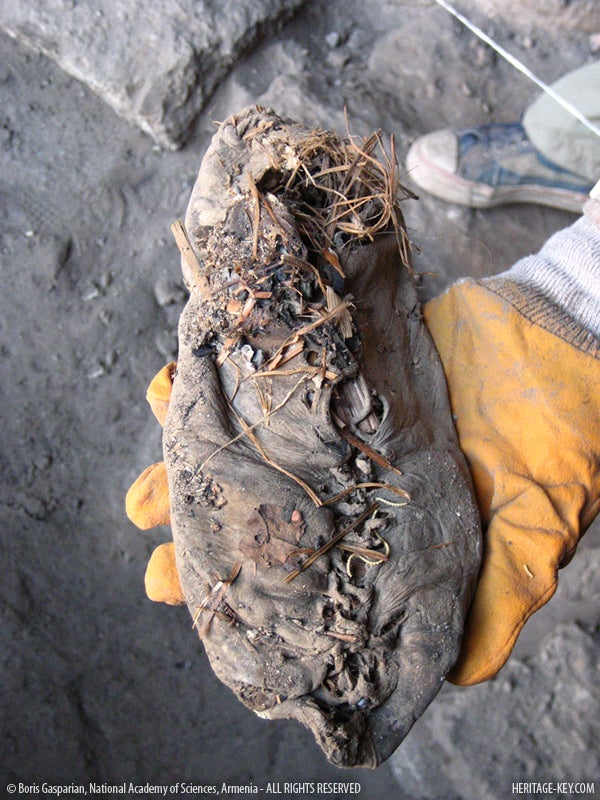Your support helps us to tell the story
From reproductive rights to climate change to Big Tech, The Independent is on the ground when the story is developing. Whether it's investigating the financials of Elon Musk's pro-Trump PAC or producing our latest documentary, 'The A Word', which shines a light on the American women fighting for reproductive rights, we know how important it is to parse out the facts from the messaging.
At such a critical moment in US history, we need reporters on the ground. Your donation allows us to keep sending journalists to speak to both sides of the story.
The Independent is trusted by Americans across the entire political spectrum. And unlike many other quality news outlets, we choose not to lock Americans out of our reporting and analysis with paywalls. We believe quality journalism should be available to everyone, paid for by those who can afford it.
Your support makes all the difference.A 5,500-year-old leather shoe – complete with laces – has been unearthed in cave in Armenia.
The perfectly preserved shoe – 1,000 years older than the Great Pyramid of Giza and 400 years older than Stonehenge – is the oldest known example of enclosed leather footwear, out-dating the shoes worn by “Ötzi the Iceman” by a few hundred years.
The sole-less right shoe is made out of a single piece of cow hide and was found containing grass, which may have served to keep the foot warm or to maintain the shape of the shoe. It is not known whether the shoe – 24.5cm long and a European size 37 – belonged to a man or a woman, though it is thought to have been best suited to a male. It has been dated to the Chalcolithic period, about 3500BC.
The discovery was made in Vayotz Dzor province on Armenia’s border with Iran and Turkey by Diana Zardaryan ,of Armenia’s Institute of Archaeology. “I was amazed to find that even the shoelaces were preserved,” she said.
The discovery – made in 2008 – has been published in the online scientific journal PloS ONE.
Such a well-preserved artifact from a Middle Eastern archaeological site is unusual because the high content of salts and fungi in the soil, as well as fluctuations in temperature and humidity, usually fast-track the deterioration of organic materials. However the cave’s stable, cool conditions – aided by a thick layer of sheep dung on the floor – aided preservation. Other finds at the site included large containers, many storing well-preserved wheat, barley and apricots, plus a broken pot, fish bones and sheep’s horns.
“We couldn't believe the discovery,” said the dig's co-director Gregory Areshian, part of an international team of archaeologists working at the site. “The crusts had sealed the artifacts and archaeological deposits, and artifacts remained fresh dried, just like they were put in a can.”
The shoe is similar to the 'pampootsies' worn until the 1950s on Ireland’s Aran Islands. “Enormous similarities exist between manufacturing technique and style of this shoe and those found across Europe at later periods,” said Dr Ron Pinhasi of Cork University. “(This suggests) that this type of shoe was worn for thousands of years across a large and environmentally diverse geographic region.
"We do not know yet what the shoe or other objects were doing in the cave or what the purpose of the cave was. We know that there are children's graves at the back of the cave but so little is known about this period that we cannot say with any certainty why all these different objects were found together." The team will continue to excavate the cave, which has multiple chambers.
While the Armenian discovery may claim the honours as the world’s oldest leather shoe, the oldest known footwear – a moccasin and a pair of leather sandals discovered in a cave in Missouri – are believed to be some 2,000 years older.
Leather sandals of a similar age to the Armenian shoe were found in Israel’s Judean Desert, but their age was based on other artefacts in the so-called Cave of the Warriors rather than on the sandals themselves.
Grey mass dating back 5,000 years. World's oldest human brain found in Armenia?
Stonehenge Summer Solstice: Where, When, What
Wembley's new £16 million Hindu temple built using ancient methods

Join our commenting forum
Join thought-provoking conversations, follow other Independent readers and see their replies
Comments